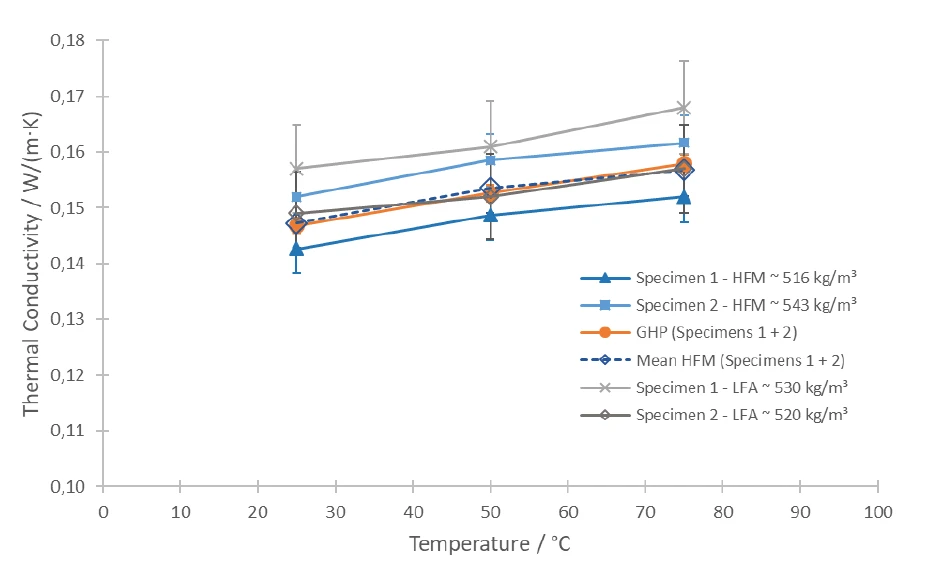Introduction
Aerated concrete is frequently used in construction, particularly for load-bearing and non-load-bearing walls, ceilings, roof structures, and facades. Due to its low DensityThe mass density is defined as the ratio between mass and volume. density and good thermal insulation properties, aerated concrete is a popular material for energy-efficient buildings. Thermal conductivity is an important parameter for quality control, but also for the research and development of new materials. Common methods for determining the Thermal ConductivityThermal conductivity (λ with the unit W/(m•K)) describes the transport of energy – in the form of heat – through a body of mass as the result of a temperature gradient (see fig. 1). According to the second law of thermodynamics, heat always flows in the direction of the lower temperature.thermal conductivity on insulating materials are the Heat Flow Meter (HFM) and Guarded Hot Plate (GHP) methods.
Laser Flash Analysis
Laser Flash Analysis (LFA) is another common method for the determination of thermal properties such as Thermal DiffusivityThermal diffusivity (a with the unit mm2/s) is a material-specific property for characterizing unsteady heat conduction. This value describes how quickly a material reacts to a change in temperature.thermal diffusivity, Specific Heat Capacity (cp)Heat capacity is a material-specific physical quantity, determined by the amount of heat supplied to specimen, divided by the resulting temperature increase. The specific heat capacity is related to a unit mass of the specimen.specific heat capacity and Thermal ConductivityThermal conductivity (λ with the unit W/(m•K)) describes the transport of energy – in the form of heat – through a body of mass as the result of a temperature gradient (see fig. 1). According to the second law of thermodynamics, heat always flows in the direction of the lower temperature.thermal conductivity. It is usually limited to non-porous materials. However, LFA can handle porous materials using the model by McMasters [1] for evaluation of the measurement signal under the following conditions:
- The material should have comparatively small pores in relation to the thickness of the sample.
- The material should be prepared with a defined geometry.
- The material should be opaque or properly coated with graphite.
Aerated concrete fulfils all of these requirements, so that this insulation material was investigated by means of LFA. To validate the LFA results, additional measurements were carried out with a heat flow meter (HFM) and a guarded hot plate (GHP).
Experimental
For the tests, two specimens were prepared from bigger blocks with dimensions of 250 mm x 300 mm x 60 mm to be suitable for HFM and GHP measurements. The specimens were investigated individually in the HFM and together in a symmetrical setup in the GHP. The temperatures were set at 25°C, 50°C and 75°C with a temperature difference of 20 K between the plates.
For the LFA measurements, two independent specimens with a diameter of 12.7 mm and thickness of 5 mm were also prepared from the same big block. The specimens were measured at the same temperature steps as with HFM and GHP. The so-called penetration model based on McMasters was used for the evaluation of the Thermal DiffusivityThermal diffusivity (a with the unit mm2/s) is a material-specific property for characterizing unsteady heat conduction. This value describes how quickly a material reacts to a change in temperature.thermal diffusivity of the LFA measurement signals. This model takes into account the penetration of light into the specimen, which is permitted by the porous surface of the aerated concrete.
The Specific Heat Capacity (cp)Heat capacity is a material-specific physical quantity, determined by the amount of heat supplied to specimen, divided by the resulting temperature increase. The specific heat capacity is related to a unit mass of the specimen.specific heat capacity, which is needed in order to calculate the Thermal ConductivityThermal conductivity (λ with the unit W/(m•K)) describes the transport of energy – in the form of heat – through a body of mass as the result of a temperature gradient (see fig. 1). According to the second law of thermodynamics, heat always flows in the direction of the lower temperature.thermal conductivity, was determined on powdery specimens by means of a Differential Scanning Calorimeter (DSC). The DensityThe mass density is defined as the ratio between mass and volume. density of all specimens was determined by measurement of the mass and volume.
Results and Discussion
Figure 1 depicts the Thermal ConductivityThermal conductivity (λ with the unit W/(m•K)) describes the transport of energy – in the form of heat – through a body of mass as the result of a temperature gradient (see fig. 1). According to the second law of thermodynamics, heat always flows in the direction of the lower temperature.thermal conductivity results, obtained with HFM, GHP and LFA methods. The Thermal ConductivityThermal conductivity (λ with the unit W/(m•K)) describes the transport of energy – in the form of heat – through a body of mass as the result of a temperature gradient (see fig. 1). According to the second law of thermodynamics, heat always flows in the direction of the lower temperature.thermal conductivity increases with increasing temperature as expected for porous materials. The influence of DensityThe mass density is defined as the ratio between mass and volume. density can also be observed. The lower the DensityThe mass density is defined as the ratio between mass and volume. density, the lower the effective thermal conductivity due to the higher amount of the low-conductive gas phase volume. The results show good agreement between the well-established methods of HFM, GHP and LFA using the penetration model based on McMasters. The maximum deviation between the different specimens and methods amounts to approx. 10%.

Conclusion
The measurements show that the LFA method is also well-suited for the characterization of porous materials. Thanks to the small specimen size, this can be of great interest for the R&D of new aerated concrete materials with a limited sample amount.